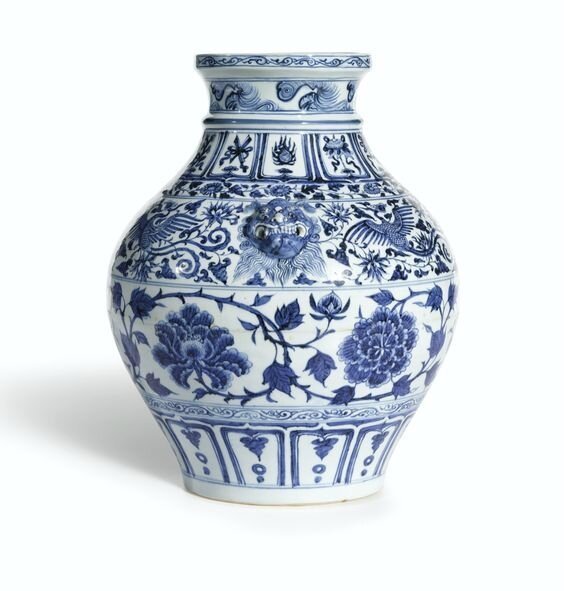A rare blue and white 'peony' jar, Yuan dynasty
Lot 17. A rare blue and white 'peony' jar, Yuan dynasty; 40.8 cm., 16 in. Estimate: 2,700,000 - 4,500,000 HKD. Lot sold 3,880,000 HKD (383,090 EUR). Photo Sotheby's
robustly potted of tall ovoid form, the rounded sides rising from a tapered base to a raised rib shoulder and a flanged towering neck (replaced), set with two animal mask handles, superbly painted in deep shades of blue accented with 'heaping and piling', the central register with a broad scroll of large peony blossoms wreathed by leafy stems, between a 'classic' scroll surmounting petal lappets at the base and a border of phoenix flying among lotus around the shoulder, all below petal lappets enclosing auspicious emblems and a border of scrolling chrysanthemums surrounding the neck, the raised animal masks pierced to hold rings and wreathed by curls of fur, each finely detailed with floppy ears, dotted eyebrows, an open mouth with clenched teeth and a long tripartite undulating beard, the replaced neck decorated with swirling waves and a 'classic' scroll at the rim, the unglazed base and broad low footring revealing a smooth white biscuit fired to pale orange.
PROVENANCE: Sotheby’s London, 15th December 1987, lot 141.
EXHIBITED: Evolution to Perfection. Chinese Ceramics from the Meiyintang Collection/Evolution vers la perfection. Céramiques de Chine de la Collection Meiyintang, Sporting d’Hiver, Monte Carlo, 1996, cat. no. 102.
LITTERATURE: Regina Krahl, Chinese Ceramics from the Meiyintang Collection, London, 1994-2010, vol. 2, no. 640.
NOTE: Although jars of this type were made largely for export, they were equally used in China, as is documented through excavated material. A very similar counterpart to this jar, decorated with dragons in place of the phoenix seen here, retaining its cover and the animal masks still holding bronze rings, is the famous jar excavated from the large hoard of middle and later Yuan ceramics on the south bank of the Jin river in Gao’an county town in Jiangxi province, southwest of Nanchang and not far from Jingdezhen. This frequently illustrated jar is published, for example, in Gao’an Yuandai jiaocang ciqi/The Porcelain from the Cellar of the Yuan Dynasty in Gao’an, Beijing, 2006, pp. 46-7; it was also included in the recent Shanghai Museum exhibition Yulan shencai. Yuandai qinghua ciqi teji/Splendors in Smalt. Art of Yuan Blue-and-white Porcelain, Shanghai, 2012, cat. no. 58, and is reproduced on the cover of the associated symposium proceedings, Yuandai qinghua ciqi guoji xueshu yanetao hui lunwen gao/International Symposium on Yuan Blue-and-white Porcelain, Shanghai, 2012.
A similar jar and cover, with a petal panel border only around the shoulder, lacking the additional flower scroll band, and with the phoenix among chrysanthemums, was sold at Christie’s London, 8th June 2004, lot 468; another phoenix-decorated jar in the Shanghai Museum, but with a lotus scroll only around the shoulder and the phoenix surrounded by chrysanthemums, was included in the Shanghai Museum’s recent exhibition, 2012, op.cit., cat. no. 8.
Such jars were still held in high esteem in the Ming dynasty as is suggested by the discovery of similar vessels in Ming tombs; for example, a jar and cover decorated with flowers and abstract designs only, from a tomb datable to AD 1395 at Caoshan, in the eastern suburbs of Bengbu, Anhui province, and now in the Bengbu Museum, included in the Shanghai exhibition, 2012, op.cit., cat. no. 64; or another from a Ming tomb at Fenghuangdun, Jiqiao village, Huaian county, datable to AD 1470, and now in the Chuzhou Museum, Huaian, Jiangsu province, illustrated in Zhongguo chutu ciqi quanji/Complete Collection of Ceramic Art Unearthed in China, Beijing, 2008, vol. 7, pl. 164.
Sotheby's. The Meiyintang Collection, Part V - An Important Selection of Imperial Chinese Porcelains. Hong Kong | 08 avr. 2013

/https%3A%2F%2Fprofilepics.canalblog.com%2Fprofilepics%2F1%2F0%2F100183.jpg)
/https%3A%2F%2Fstorage.canalblog.com%2F03%2F02%2F119589%2F96711876_o.jpg)
/https%3A%2F%2Fstorage.canalblog.com%2F11%2F31%2F119589%2F94773502_o.jpg)
/https%3A%2F%2Fstorage.canalblog.com%2F20%2F83%2F119589%2F94772815_o.jpg)
/https%3A%2F%2Fstorage.canalblog.com%2F26%2F72%2F119589%2F75604929_o.jpg)
/https%3A%2F%2Fstorage.canalblog.com%2F59%2F60%2F119589%2F26458628_o.jpg)





/image%2F1371349%2F20240416%2Fob_2a8420_437713933-1652609748842371-16764302136.jpg)
/image%2F1371349%2F20240414%2Fob_83ee65_2024-nyr-22642-0954-000-a-blue-and-whi.jpg)
/image%2F1371349%2F20240414%2Fob_15808c_2024-nyr-22642-0953-000-a-blue-and-whi.jpg)
/image%2F1371349%2F20240414%2Fob_e54295_2024-nyr-22642-0952-000-a-rare-blue-an.jpg)